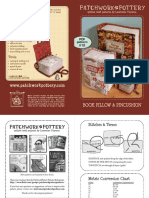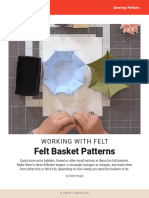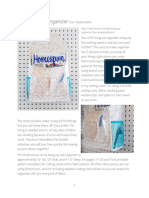Tips Small
Tips Small
Uploaded by
yamezz123Copyright:
Available Formats
Tips Small
Tips Small
Uploaded by
yamezz123Copyright
Available Formats
Share this document
Did you find this document useful?
Is this content inappropriate?
Copyright:
Available Formats
Tips Small
Tips Small
Uploaded by
yamezz123Copyright:
Available Formats
Embroidering
on felt
Materials:
I recommend using good quality wool
felt. It is expensive, but the amounts
are small and working with good
quality felts and thread mean that it
is easier to get a better result. A
thinner felt is harder to embroider
and can pucker, pill and crease
easier. Acrylic felt can melt when
you iron it.
Good quality embroidery threads are also essential.
Embroidery threads are made of six strands that
separate quite easily. For most applications use 2
threads together. When cutting thread to sew with,
use a piece no longer than the distance from your
elbow to the tips of your fingers. Longer lengths are
harder to work with and can result in you stabbing
the people next to you. !
I like to use carded wool as stuffing, but polyfil
stuffing works just fine too. When stuffing, use small
pieces of stuffing and work them into the smallest
places first – ears, paws etc. Use a blunt point such
as the wrong end of a paintbrush or a large knitting
needle to get the stuffing into small parts.
Note: If you are making toys for children then make
sure all your materials are child safe – made with child-
safe dyes. Sew any small pieces on really securely.
Replace buttons with small circles of felt and sew on all
the way around.
Other equipment:
Embroidery or Crewel needles are the best to use as they
have a sharp point and a large eye. They come in sizes 1-
12. Sizes 9-10 are usually fine for all purposes.
A sharp scissors is essential to cut felt accurately. A
small embroidery scissors is also handy for cutting
threads close to your felt and for cutting small details on
felt.
© Caroline Walshe 2014. All rights reserved. www.makermagpie.com Page 1
A note on colour:
In the patterns there are many substitutes that can be made for the different colour
threads and felts. Sometimes a contrasting thread will really bring out the shape of a piece
and define it, and sometimes you might want to change to a matching thread to make the
sewing less obvious. Experiment with it and choose colour combinations you like. I mostly
use dark brown thread instead of black and cream instead of white as they are not as stark
as using pure black or white.
Cutting out felt:
There are many ways to transfer patterns and cut felt. Here
are my favourites.
1. Tape your pattern to your felt and cut around it.
Roughly cut out the paper pattern piece, then use tape to
stick this on your felt. Tape all edges and cut around the
pattern, through the paper, felt and tape at the same time.
This is very accurate and great for small pieces.
2. Staple or pin your pattern to your felt and cut around
it. An alternative to taping. Be careful when removing
staples afterwards.
3. Use an iron-on transfer pen. A description for this is given below (In Transferring
Designs.) If any pen marks are showing on the piece you can turn it so the marked side
faces inwards. Remember to flip the pattern before you cut the next piece out so the pen
marks will be on the inside of the next piece too.
4. Use freezer paper/greaseproof paper. Trace the pattern onto the papery side, then iron
the plasticy side onto your felt. Cut around it and peel it off.
Tip: Whichever way you work, remember that you are using small pieces and felt by its
nature can be fuzzy and inaccurate, so trim any pieces where necessary to fit.
© Caroline Walshe 2014. All rights reserved. www.makermagpie.com Page 2
Transferring designs:
There are a few different ways to do this.
1. Stitch through tissue paper. This method can be less
accurate than other methods but leaves no marks on your
felt. This works best with small stitches as it can pull larger
stitches loose somewhat.
Trace your design onto tissue paper and pin, staple or baste
this onto your felt. Stitch the design through it and at the
end pull off the paper. You may need a tweezers to pull the
pieces out from under the stitches. If it loosens your stitches
then use the wrong end of a needle on the reverse side of the
stitches to pull a little on them and tighten any loose ones. If
you choose this method then in the pattern where it says to
mark your felt, just cut a piece of tissue paper and trace the
markings on to that. Pin, baste or staple it to your felt and
off you go stitching.
2. Use an iron-on transfer pen. This method is very accurate but can leave pen marks on
your felt. Trace the design onto a sheet of tracing paper, then on the reverse side of the
tracing paper, use your transfer pen to retrace the design (this will reverse it). A thin line
is best as you will see it unless you stitch over it entirely. Use an iron to iron this onto your
felt following the instructions on the pen. You may want to check how your felt responds to
ironing first – ironing acrylic felt is a bad plan - it melts!
3. Use freezer paper/greaseproof paper. Trace the design onto the papery side, then iron
the plasticy side on to your felt. It will stick to the felt and you can embroider through it
then pull it out at the end.
Tip: With a light coloured felt it can be better to use the tracing paper or freezer paper
method, as dark pen marks can be hard to hide.
When embroidering:
Good quality felt is too thick to put into an embroidery hoop while
you work on it (and will stretch out of shape if you try) but is stiff
enough to embroider without being stretched in a hoop. (Good
quality wool felt is also expensive so putting it in a hoop means
wasting too much of it.) Take care when pulling your stitches not to
pull them too tight and gather your felt. Keep an eye on your tension
– keep your stitches tight enough to make them neat but not so tight
that the felt will pucker.
Starting and finishing:
If you will not see the back of your felt then tie a knot in the end of your thread to secure it.
If the reverse side will be visible then leave 3”/7cm of thread hanging out the back and
weave this in through the back of the stitches when you have finished. Likewise with
finishing a thread – if it will not be visible then just knot it, but if you will be able to see the
back then weave the end in through the stitches on the back.
© Caroline Walshe 2014. All rights reserved. www.makermagpie.com Page 3
Losing your thread:
When you finish stitching around the outside of a stuffed piece, knot
the thread and push the needle through the piece, bringing it out
c.1”/2.5cm away, then cut it. This is called losing your thread. If you
are working on only one layer of thick felt and need to lose your
thread you can sew through the thick felt to lose it. (Photo at right.)
Embroidering so that no stitches show on the back:
Sometimes it is necessary to sew through only the top layer of your
bottom felt, so that the stitches do not show through on the other
side of the felt. To do this, bend the felt so that you can push the
needle only through the top half of the felt underneath – for example
with the white felt at right, the needle is only going part of the way
through it so the blue stitches do not show on the other side.
Knotting:
My favourite way to tie a knot is like this:
1. Loop the thread twice around your index finger, keeping tension
on the other end. Pinch the thread between index and thumb.
2. Roll your thumb forward to roll the thread around itself.
3. Roll it off your finger, keeping a firm grip to hold the knot and pull
on the other end of the thread until the knot pulls tight.
© Caroline Walshe 2014. All rights reserved. www.makermagpie.com Page 4
Stitches
Straight stitch
Straight stitch is the simplest stitch
and involves bringing the needle in
and out to make small stitches. It
can be done in different ways –
straight or curved lines of stitches,
single stitches or stitching round a
shape. When stitching around a
shape, the stitches should be
perpendicular to the edge of the
shape.
French Knot
Pull the needle up through the felt where you want the knot. Hold the thread in your non-
dominant hand, keeping some tension on it. Wrap the thread twice around the needle. Push
the tip of the needle down through the felt just beside (but not in the same hole) where it
came up. Pull the thread tight so the loops are tight and keep the tension on the thread as
you pull the needle through.
Arrowhead stitch
Bring your needle up through the fabric at 1 (The top
left of the V)
Bring the needle back down through the fabric at 2
(Bottom of the V)
Bring the needle back up at 3 (Top right of the V)
Bring the needle back down at 2 (Bottom of the V)
Repeat.
© Caroline Walshe 2014. All rights reserved. www.makermagpie.com Page 5
Back stitch
This is a really useful stitch for making solid lines.
Begin by bringing the needle up through the fabric at 1.
Go down through the fabric at 2.
Come back up at 3. (This now becomes point 1.)
Continue as established.
Note: When starting a line, start at point “a” - one-eighth
of an inch/a few millimeters to the left of the end of the
line.
When turning around curves or on fine details use smaller stitches for a smooth line.
Satin stitch
Satin stitch is used for filling an area completely.
If the area is thinner at the ends then start in the
biggest part and work outwards.
Bring the needle up through the fabric at the top of the
area you wish to fill.
Bring the needle back down at the bottom of the area.
Bring the needle back up just beside the first stitch.
Bring the needle back down just beside the previous
stitch.
Continue working each stitch right up against the previous one to fill the area completely.
Fishbone Stitch used as a seam
Fishbone stitch worked horizontally over two pieces of felt
makes for a good hinged join. Think of it like lacing a shoe.
Begin by bringing the needle up through the right felt at 1.
Take the needle between the pieces of felt and underneath the
left fabric to come out at 2.
Now take the needle between the pieces of felt and underneath
the right felt to come out at 3.
Repeat the above two steps.
© Caroline Walshe 2014. All rights reserved. www.makermagpie.com Page 6
Blanket stitch
This is a great stitch for sewing two pieces of felt together and gives
a lovely edging.
Tip: When sewing more than 2 layers of felt together, trim the
inside layers a little so they do not show if they are a different colour
to the outside layers.
1. To start blanket stitch, bring your knotted thread between the
two pieces of felt, and sew through the front piece, towards you.
2. Bring your needle to the back and sew through the back felt
bringing the needle up between the pieces of felt. Pull the thread
through.
3. Loop the needle through the stitch you just made from right to
left.
4. Pull tight. This forms the first stitch.
5. Continue with blanket stitch – bringing the needle from front to
back and to the left of the previous stitch. Make a loop of the thread
and bring the needle up through it, then pull tight.
© Caroline Walshe 2014. All rights reserved. www.makermagpie.com Page 7
5. Keep sewing until you reach the last stitch.
6. Bring the needle under the bar at the top of the first stitch and
make a knot around it.
7. Lose the thread, by bringing the needle in between the two layers
of felt and out an inch or two/5cm away.
Changing threads in blanket stitch:
If you run out of thread in the middle of sewing or want to change colour, knot your thread
around the bar at the top of the last stitch you just sewed. Bring the loose end down
between the layers of felt. Rethread your needle and tie a knot in it. Bring the needle up
through the knot you just made at the top of the last bar and continue as normal. Tuck the
end of the new thread between the layers of felt.
Decorative Blanket Stitch
To do this, vary the length of the stitches as you go, repeating a pattern
of stitch lengths: small, medium, large, medium, repeat, etc.
Blanket Stitch as edging
Blanket stitch can also be done as an edging on a piece that is sewn
onto another piece of felt, as pictured at right.
© Caroline Walshe 2014. All rights reserved. www.makermagpie.com Page 8
Whip Stitch
Use whip stitch to attach two edges together by making small
stitches c. an eighth of an inch/3mm from the edge.
1. Start by knotting the thread and bringing it between the two
pieces of felt towards you.
2. Make the first stitch by bringing the needle round the back of
your work and sew through both layers of felt, coming out the
same hole on the front felt.
3. Now push the needle in the same hole in the back felt, at an
angle and out just to the left of the last stitch on the front.
4. Continue making small stitches, angling your needle as you go.
5. When you get to the last stitch, push the needle through the
back layer only, coming out between the two layers of felt and knot
it.
© Caroline Walshe 2014. All rights reserved. www.makermagpie.com Page 9
6. Flatten out your piece.
Tip:
Sometimes you cannot fold your edges so that they are together. In
this case hold the edges together while doing whip stitch as shown
at right.
Reversible back stitch
This is a useful stitch when you have a piece of felt that you can
see both sides of.
Sew a row of straight stitches up your felt.
Then sew small stitches in between the ones you just made. This
will give you a solid line of stitches on both sides.
Tip: Take care to keep checking both sides as you sew as it will be
necessary to angle your needle at times to make sure the stitches
are neat on both sides.
These pattern notes are protected by copyright law. Please do not copy these notes or email copies to friends. I rely on the
honesty of my customers to support my shop. Thanks in advance for respecting my copyright.
Patterns are for personal use only. For information on buying a license to make items to sell from my patterns please
email me: makermagpie@gmail.com
© Caroline Walshe 2014. All rights reserved. www.makermagpie.com Page 10
You might also like
- CROSSTOWN_CRESCENT_BAG_INSTRUCTIONSDocument17 pagesCROSSTOWN_CRESCENT_BAG_INSTRUCTIONSMerikoNo ratings yet
- Hestu ZeldapatternDocument54 pagesHestu Zeldapatternamaii hime100% (1)
- Materials: Book Pillow & PincushionDocument8 pagesMaterials: Book Pillow & Pincushionfrf100% (1)
- Docslide - Us Alex Elmsley Penelopes PrincipleDocument2 pagesDocslide - Us Alex Elmsley Penelopes PrincipleLeonardo MacedoNo ratings yet
- Punch Needle EmbroideryDocument4 pagesPunch Needle EmbroiderysamsonadebogaNo ratings yet
- Sera - Honey BowDocument5 pagesSera - Honey BowCaroline DunfordNo ratings yet
- Free Ebook Felting PDFDocument13 pagesFree Ebook Felting PDFjohn jajaNo ratings yet
- Retro Felt Deer From Mollie Makes ChristmasDocument16 pagesRetro Felt Deer From Mollie Makes ChristmasKimberly Partain McNamaraNo ratings yet
- Instruções Saquinho PatchworkDocument3 pagesInstruções Saquinho PatchworkMartha SantanaNo ratings yet
- Christmas Tree: Hand Embroidery PatternDocument6 pagesChristmas Tree: Hand Embroidery PatternNavidadNo ratings yet
- Pattern - by - Duftin - EmbroideryDocument11 pagesPattern - by - Duftin - Embroiderylagrimasdeflor93No ratings yet
- Kasuti Embroidery: Making Sense of Handloom and HandicraftDocument19 pagesKasuti Embroidery: Making Sense of Handloom and HandicraftAman AnimeshNo ratings yet
- PATTERN Leather Hobo BagDocument6 pagesPATTERN Leather Hobo Bagmozdemirr554No ratings yet
- SEW Working With Felt Hough CraftsyDocument16 pagesSEW Working With Felt Hough CraftsyamyNo ratings yet
- Simply Redwork TemplatesDocument13 pagesSimply Redwork TemplatesMayumi KawamotoNo ratings yet
- FREE Silk Pleated and Darted Purse TutorialDocument14 pagesFREE Silk Pleated and Darted Purse TutorialaburidaNo ratings yet
- Lovely BagDocument5 pagesLovely BagRivan Eleraki100% (2)
- Ipad Laptop CaseDocument4 pagesIpad Laptop Casejulieta_g_No ratings yet
- Leao FREE Miss Felt DesignsDocument4 pagesLeao FREE Miss Felt DesignsMárcia NovaisNo ratings yet
- How To Make A Travel BAG KitDocument9 pagesHow To Make A Travel BAG Kitonuk mooncakeNo ratings yet
- ZipperPouch CosturaDocument7 pagesZipperPouch CosturaPatricia SantosNo ratings yet
- Sac Pour Suspendre Avec PochettesDocument20 pagesSac Pour Suspendre Avec PochettesLyne BoucherNo ratings yet
- MaretaThreads BoleroDocument7 pagesMaretaThreads BoleroSofi SNo ratings yet
- Project: Season's Best Ornaments: American Patchwork & Quilting - Quilt Sampler - Quilts and MoreDocument6 pagesProject: Season's Best Ornaments: American Patchwork & Quilting - Quilt Sampler - Quilts and MoreelantunteixNo ratings yet
- Beach Bound Straw Tote by Melissa Mortenson For WeAllSew PDFDocument10 pagesBeach Bound Straw Tote by Melissa Mortenson For WeAllSew PDFGeorgeta TanasescuNo ratings yet
- Materials: House Tape MeasureDocument8 pagesMaterials: House Tape MeasurefrfNo ratings yet
- 776 Sewing Instruction PayDocument18 pages776 Sewing Instruction PayBianca Cristina LuputNo ratings yet
- Emerald HandbagDocument3 pagesEmerald HandbagCanda Ribeiro100% (1)
- Ipad Case TutorialDocument4 pagesIpad Case TutorialSonny Jason ApacibleNo ratings yet
- Dog Shirt Patterns - PDF PATTERN - Mimi & TaraDocument24 pagesDog Shirt Patterns - PDF PATTERN - Mimi & Taraflanna.gazdaNo ratings yet
- Creative Machine Embroidery Jan Feb 2017Document60 pagesCreative Machine Embroidery Jan Feb 2017Mel JohnsonNo ratings yet
- FA11 SlouchBagDocument3 pagesFA11 SlouchBagFemi Alabi0% (1)
- Love Patchwork Quilting - Issue 128 2023Document100 pagesLove Patchwork Quilting - Issue 128 2023pytlesia100% (1)
- A Spoonful of Sugar Designs Travel Sewing KitDocument12 pagesA Spoonful of Sugar Designs Travel Sewing KitCali MeroNo ratings yet
- Flareon Add-On Patterns by TeacuplionDocument14 pagesFlareon Add-On Patterns by TeacuplionrocambolheNo ratings yet
- 1250 Pattern PDFDocument7 pages1250 Pattern PDFDiana Romero VilaNo ratings yet
- Free Sewing PatternsDocument14 pagesFree Sewing PatternsEdit UlakiNo ratings yet
- Flareon Add-On Patterns by TeacuplionDocument14 pagesFlareon Add-On Patterns by TeacuplionJullyanny BinottiNo ratings yet
- Sewing Instructions Backpack Valentina Bukeeva ENDocument53 pagesSewing Instructions Backpack Valentina Bukeeva ENStrimbu ValentinNo ratings yet
- Calico Pear PincushionDocument4 pagesCalico Pear Pincushionsassy100% (4)
- Diy Open Wide Pouch (Sewingtimes)Document10 pagesDiy Open Wide Pouch (Sewingtimes)PerrineColignon0% (1)
- Bolso BoniDocument5 pagesBolso BoniVictoria Zarate Novoa100% (1)
- Christmas Metallics Quilt ProjectDocument3 pagesChristmas Metallics Quilt ProjectkarennlmurilloNo ratings yet
- BUCKETbagwithstrap A4Document9 pagesBUCKETbagwithstrap A4sheko.supNo ratings yet
- Patchwork Bunny: SuppliesDocument6 pagesPatchwork Bunny: SuppliesSammBrunetteNo ratings yet
- Convertible Clutch PDFDocument5 pagesConvertible Clutch PDFjulieta_g_No ratings yet
- CavalinhoDocument10 pagesCavalinhoJane Dutra100% (1)
- Sapatinho Laço DuploDocument11 pagesSapatinho Laço DuploNatália BarbosaNo ratings yet
- Jaguar Embroidery - Bustle & Sew PatternDocument4 pagesJaguar Embroidery - Bustle & Sew PatternMaria Jose Lopez NeedhamNo ratings yet
- Cloth Baby Shoe TutorialDocument7 pagesCloth Baby Shoe TutorialSvetlana LucenaNo ratings yet
- Patch WorkDocument1 pagePatch WorkCamila OrellanaNo ratings yet
- OrganizadorDocument2 pagesOrganizadorelainefteatin100% (2)
- Slouchy CrossbodyDocument18 pagesSlouchy Crossbodyfanm_belNo ratings yet
- Dfpo 6 JyDocument10 pagesDfpo 6 Jycecilia davisonNo ratings yet
- Sac À CouchesDocument22 pagesSac À CouchesLyne BoucherNo ratings yet
- Cme Ebook 11Document12 pagesCme Ebook 11MarittaKarmaNo ratings yet
- The Perennial Dress Pattern by SewponyDocument13 pagesThe Perennial Dress Pattern by Sewponysewpony100% (2)
- Sock Dragon - Free Sewing Pattern - Craft Passion - Page 2 of 2Document10 pagesSock Dragon - Free Sewing Pattern - Craft Passion - Page 2 of 2noneNo ratings yet
- Book Cover FabricDocument4 pagesBook Cover FabricTrish Hanson100% (1)
- Adorable Appliqué Sewing Projects: Patterns and Step-by-Step Instructions for Making Fashion Accessories and Home DécorFrom EverandAdorable Appliqué Sewing Projects: Patterns and Step-by-Step Instructions for Making Fashion Accessories and Home DécorNo ratings yet
- Chaleco para Bebe ÜDocument46 pagesChaleco para Bebe Ünataliamartin1498No ratings yet
- Manual Operators Hcr2 Version14Document250 pagesManual Operators Hcr2 Version14Railton Da Costa RodriguesNo ratings yet
- Halloween Scavenger Hunt KeyDocument2 pagesHalloween Scavenger Hunt KeyajNo ratings yet
- MaretaThreads BoleroDocument7 pagesMaretaThreads BoleroSofi SNo ratings yet
- Shop Kit: Sarah ZimmermanDocument3 pagesShop Kit: Sarah ZimmermanMaria GulraizeNo ratings yet
- Denim Production Process Chart: Denim Fabric Raw Material Fabric Inspection Cutting of FabricDocument8 pagesDenim Production Process Chart: Denim Fabric Raw Material Fabric Inspection Cutting of FabricVikas KewatNo ratings yet
- Elna Experience 620 Sewing Machine Service ManualDocument38 pagesElna Experience 620 Sewing Machine Service Manualiliiexpugnans100% (1)
- AMIGURUMIZEBRAFINCHFREECROCHETPATTERN-Projectarian 1712885798183Document12 pagesAMIGURUMIZEBRAFINCHFREECROCHETPATTERN-Projectarian 1712885798183pearl ikebuakuNo ratings yet
- Advance SpinningDocument14 pagesAdvance SpinningArun Yadav100% (1)
- Assignment 1: Kimono Dress: Subject: Dress Pattern DesignDocument7 pagesAssignment 1: Kimono Dress: Subject: Dress Pattern DesignFaizan AhmedNo ratings yet
- Harley Placket Tunic PatternDocument36 pagesHarley Placket Tunic PatternAzreg AminaNo ratings yet
- Pecha KuchaDocument2 pagesPecha KuchaWilly WonkaNo ratings yet
- Tajima TMM User ManualDocument5 pagesTajima TMM User ManualdanielNo ratings yet
- Mottled Shade Sweater Free Jumper Crochet Pattern For Women in Paintbox Yarns Cotton 4 Ply by Paintbox Yarns - 2Document10 pagesMottled Shade Sweater Free Jumper Crochet Pattern For Women in Paintbox Yarns Cotton 4 Ply by Paintbox Yarns - 2luv.sun100% (1)
- Q3-WEEK 1 New EditedDocument2 pagesQ3-WEEK 1 New Editedmarkelvin ragosNo ratings yet
- Company ProfileDocument2 pagesCompany ProfileMyustafizz100% (1)
- TTQC 2 Assignment PDFDocument25 pagesTTQC 2 Assignment PDFJatul Akmam RahiNo ratings yet
- Peppermint SamfordSet Pants - Sewing InstructionDocument16 pagesPeppermint SamfordSet Pants - Sewing InstructionpearlyriverNo ratings yet
- Sheep Small Sheep - ENGDocument13 pagesSheep Small Sheep - ENGsvsadoraNo ratings yet
- Instagram Pro Ile: @lysenkocrochetDocument14 pagesInstagram Pro Ile: @lysenkocrochetSolsodumNo ratings yet
- Advent CalendarDocument12 pagesAdvent CalendarLinda LouisNo ratings yet
- Instant download Fashion from concept to consumer Ninth Edition Frings pdf all chapterDocument81 pagesInstant download Fashion from concept to consumer Ninth Edition Frings pdf all chaptermuijeniaconi100% (2)
- Cotswolds Crochet CleffaDocument14 pagesCotswolds Crochet CleffaNairane100% (1)
- Grade 8 - Recount TextDocument4 pagesGrade 8 - Recount Textwulan savitri davisNo ratings yet
- Well Come To This Slide Presentation: Bismilla Hir-Rah Ma-Nir-RahimDocument22 pagesWell Come To This Slide Presentation: Bismilla Hir-Rah Ma-Nir-RahimDyeing DyeingNo ratings yet
- Icethebear EnglishpatternDocument16 pagesIcethebear Englishpattern7tdh49bs7h100% (1)
- Effect of Pile Density On Physical Properties of Terry Towel FabricDocument3 pagesEffect of Pile Density On Physical Properties of Terry Towel FabricSubramani PichandiNo ratings yet
- Amor DressmakingpptDocument18 pagesAmor DressmakingpptCha Ar RiahNo ratings yet
























































































